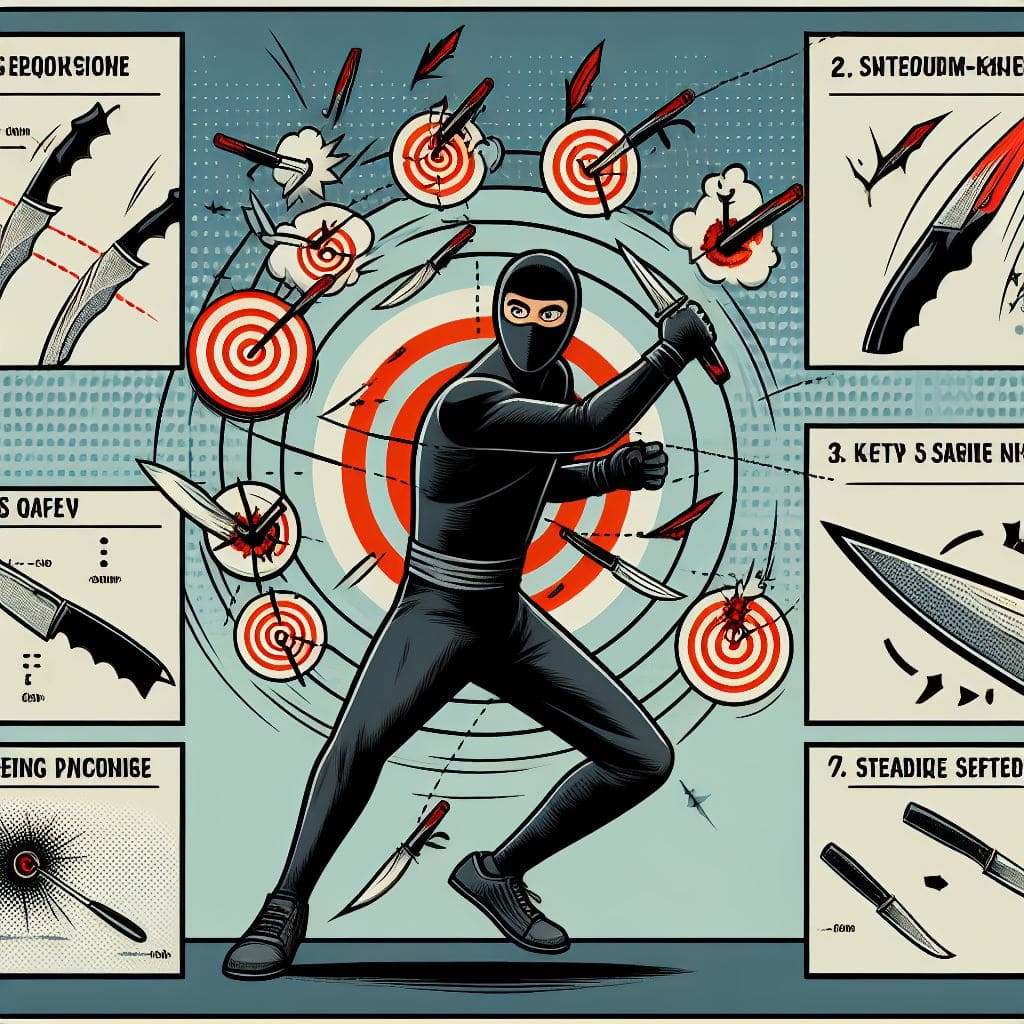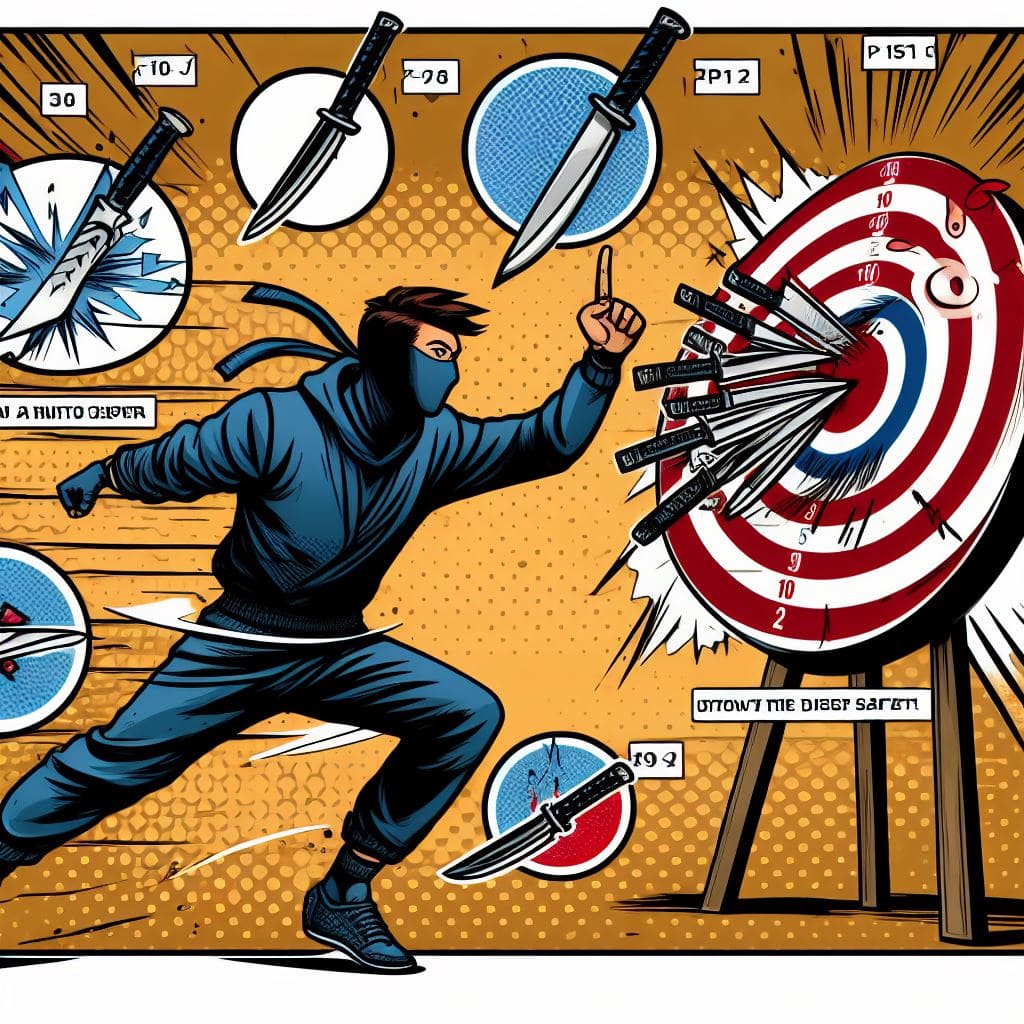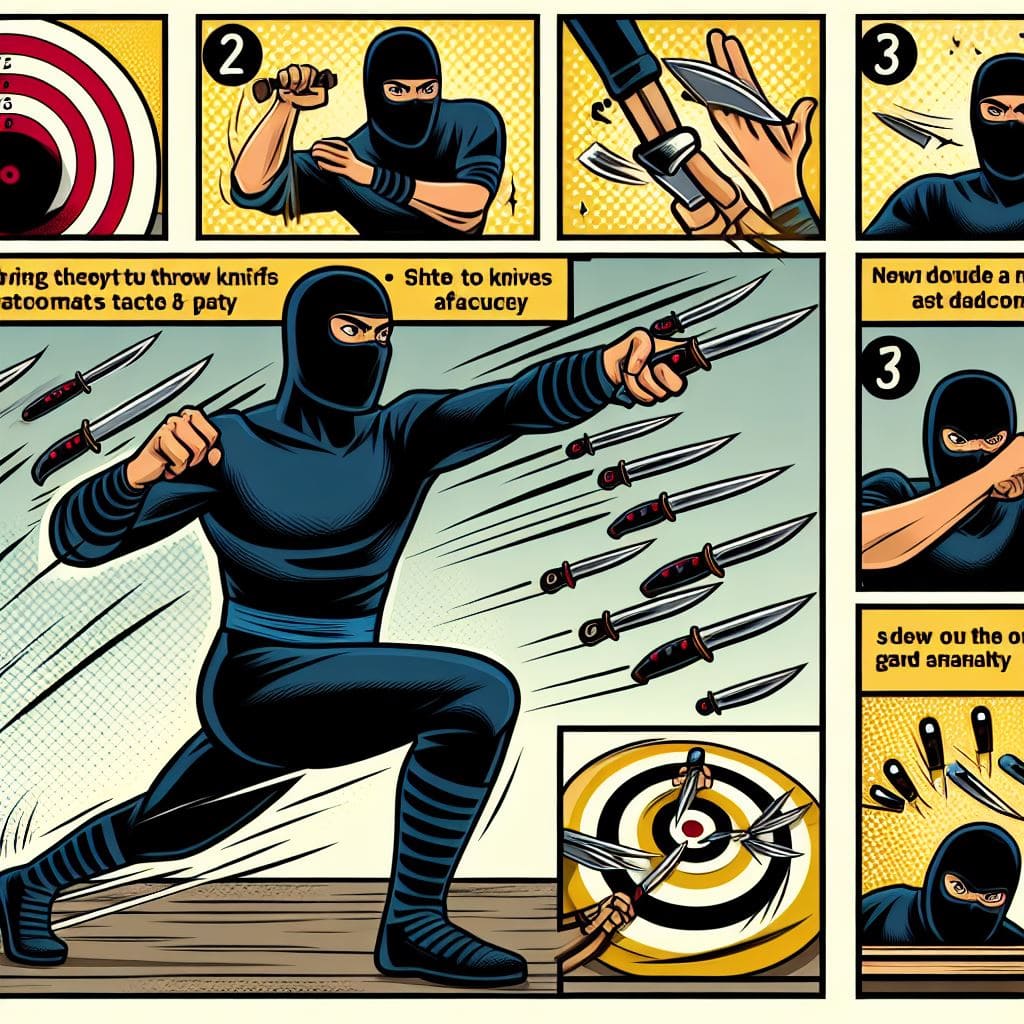To learn knife throwing, select a proper knife and adopt a balanced stance. Practice your grip, aim steadily, and release with a consistent motion.
Learning to throw knives is an intriguing skill that requires precision, control, and patience. It begins with choosing the right equipment; a balanced throwing knife is essential for consistent performance. Mastering the grip and finding a comfortable stance are the foundations of this art.
As a beginner, focus on developing a smooth throwing motion and strive for accuracy before attempting longer distances or trick shots. It’s important to train in a safe, controlled environment, ideally with professional guidance to perfect your technique. Perfecting your aim involves a blend of concentration, body mechanics, and practice. With dedication and the right approach, knife-throwing can become a rewarding hobby or a competitive sport.

Introduction To Knife Throwing
Knife throwing is both an ancient practice and a modern hobby; it’s a thrilling blend of sport, self-discipline, and performing art that captivates enthusiasts across the globe. If you’ve ever dreamed of mastering this skill, understanding its rich history, various knife types, and fundamental safety measures is essential. Read on to unlock the secrets of this captivating discipline and start your journey towards becoming a proficient knife thrower.
The History And Art Of Knife Throwing
The roots of knife throwing extend far back into human history, serving as a survival skill for ancient hunters and warriors. Over the centuries, it evolved into a martial art for some cultures and a performance art for entertainers in circuses and sideshows. Today, knife throwing thrives as both a competitive sport and a recreational activity, with numerous clubs and societies dedicated to honing and preserving this age-old practice.
Understanding The Different Types Of Throwing Knives
Not all knives are created equal, especially when it comes to throwing. Different designs, weights, and lengths play a critical role in the physics of knife throwing. Here are the main types of throwing knives you’ll encounter:
- Blade-heavy knives – These knives have more weight on the blade and are generally easier for beginners.
- Handle-heavy knives – The center of gravity is closer to the handle, often preferred by experienced throwers.
- Balanced knives – These have a center of gravity at the knife’s center, providing the most consistent flight and are versatile for various throwing styles.
Choosing the right knife depends on your throwing technique and personal preference, with balanced knives often recommended for those just starting out.
Safety First: Precautions And Preparations
Your safety and the safety of others should always be the top priority in knife throwing. Before even picking up a knife, ensure you’re taking the necessary precautions:
- Always throw in a clear, designated area free of any hazards or onlookers.
- Use a proper target that’s soft enough to catch the knife without causing ricochets.
- Wear appropriate clothing and eye protection to minimize the risk of injury.
Set up your throwing practice with these safety guidelines firmly in place. Remember, a fun experience with knife throwing is a safe one, where risks are minimized and precautionary measures are second nature.
Getting Started With Knife Throwing
Welcome to the exhilarating world of knife throwing, a skill that combines focus, precision, and daring. Embarking on your knife-throwing journey can be both thrilling and methodical, involving a blend of art and science. To make your foray into this niche hobby as seamless as possible, let’s explore the fundamentals of getting started with knife throwing. We’ll dive into selecting the ideal knife, preparing your practice area, learning the basic stance and grip, and finally, mastering the mechanics of the throw.
Choosing The Right Knife For Beginners
The tool of the trade is the most crucial aspect to consider. A beginner’s knife should be:
- Well Balanced: This makes the learning process more manageable.
- Adequate Weight: Heavy enough to ensure stability in flight but not cumbersome.
- Durable: Constructed from quality materials to withstand repeated impact.
Starting with a specific design intended for throwing, such as throwers with no sharp edges, reduces the risk of injury and improves learning efficiency.
Setting Up Your Throwing Area
Prioritizing safety, the throwing zone requires:
- A secure backdrop such as a wooden board or specialized target.
- Enough clear space, ensuring no persons or pets wander into the vicinity.
- Proper lighting, to keep visibility high and shadows to a minimum.
Remember to always adhere to local regulations and maintain a safe and responsible practice environment.
Essential Stance And Grip Techniques
Your physical approach indicates success in knife throwing. The basics include:
- Stance: Feet shoulder-width apart, with one foot slightly forward for balance.
- Grip: Hold the thrower by the handle or blade, depending on the knife design, using a firm but not overly tight pinch grip.
- Arm Position: Keep your elbow slightly bent and your wrist locked to avoid unnecessary movement at release.
A consistent stance and grip technique acts as the foundation for developing accuracy and style.
The Mechanics Of The Throw: Angle, Rotation, And Distance
Mastering the throw encompasses understanding:
| Aspect | Explanation |
|---|---|
| Angle | Align the knife’s trajectory with the target for a straightforward path. |
| Rotation | Manage spin by adjusting the grip and release point; typically, beginners start with the half-spin technique. |
| Distance | Begin at a shorter distance, gradually increasing as your skill improves to maintain control over knife rotation. |
Understanding the precise dynamics of each throw elevates your knife throwing from a casual pastime to a disciplined art form.
Advanced Techniques And Tricks
Welcome to the next stage of your knife-throwing journey – mastering Advanced Techniques and Tricks. Elevate your skills beyond the basics and impress onlookers with these captivating maneuvers. From the complexity of no-spin throws to the finesse required for show-stopping performances, this section delves into the artistry and precision of advanced knife throwing.
Mastering No-spin And Half-spin Throws
Conquering the art of no-spin throws is a testament to a thrower’s skill. This technique, where the knife travels through the air without rotating, demands calibration of distance, angle, and release. Here’s how to do it:
- Ensure a firm grip on the knife’s handle or blade, depending on your comfort level.
- Align your throw by pointing the knife directly at the target.
- Focus on a smooth release with minimal wrist movement.
- Practice consistently to refine your control and accuracy.
For half-spin throws, a slight rotation is introduced. Perfecting this technique involves:
- Holding the knife at the balance point.
- Introducing a minor wrist flick to induce rotation.
- Timing the release precisely for the knife to complete just a half-spin before impacting the target.
Learning Throwing From Various Distances
Knife throwing isn’t just about skill but also adaptability. Proficient throwers can hit targets from multiple distances. Key points to master include:
- Identify the appropriate knife for the distance you’re aiming to cover.
- Adjust your stance and gripping technique as the distance changes.
- Develop a keen sense for changes in weight and balance for different knives and distances.
- Experiment with both spin and no-spin techniques across varying ranges.
Throwing Multiple Knives In Succession
To keep an audience engaged, throwing multiple knives in quick succession can be thrilling. To excel in this:
- Practice a consistent rhythm to ensure each throw aligns with your reflexes.
- Work on your muscle memory to seamlessly switch from one throw to the next.
- Balance speed and precision—maintain a steady pace while still hitting the mark.
- Alternate hands if ambidextrous, for a more dynamic performance.
Creative And Showmanship Throws For Performance
Knife throwing transforms into an art when grace and showmanship take center stage. Creative throws captivate and amaze spectators. Here’s what to consider:
- Infuse personality into each throw—curate a signature style or trademark move
- Integrate elements of danger, such as blindfolded throws, to elevate suspense and excitement.
- Mix up the types of knives and targets to maintain variety in your performance.
- Pair throws with a narrative or music for a theatrical touch.

Practicing And Improving Your Skills
Mastery in knife throwing doesn’t happen overnight. It involves a blend of precision, focus, and a substantial amount of practice. To hurl a knife accurately and consistently, it’s essential to dive into a well-structured practice routine. This section delves into creating a robust practice regimen, troubleshooting common hurdles, maintaining your equipment in top shape, and becoming part of a knife-throwing community to take your skills to new heights. Let’s sharpen your abilities and aim for a bullseye.
Designing A Systematic Practice Regimen
Establish a routine with clear objectives and measurable goals. This approach ensures steady progress and keeps you motivated. Here’s how to structure your regimen:
- Define your goals: Whether it’s increasing accuracy or throwing from greater distances, set specific targets.
- Warm-up exercises: Begin each session with a series of stretches and light throws to prepare your muscles.
- Skills drill: Dedicate time to practice different throwing techniques and stances.
- Recording progress: Keep a log of your throws to monitor improvements and identify areas needing work.
Overcoming Common Challenges And Plateaus
Progression in knife throwing might wane after initial improvements. To break through plateaus, consider the following tactics:
- Experiment with various knife weights and sizes to find what suits you best.
- Adjust your throwing stance and grip for a better throwing motion and release.
- Seek feedback from experienced throwers or coaches who can provide invaluable insights.
- Incorporate mental rehearsal and visualization techniques to enhance focus and muscle memory.
Maintenance And Care For Your Throwing Knives
Keeping your knives in pristine condition is vital for optimal performance. Implement these care tips:
| Care Aspect | Recommended Action |
|---|---|
| Cleaning | Wipe blades after each practice to prevent rust and residue build-up. |
| Sharpening | Maintain a sharp edge using a whetstone or a honing rod, as dull knives can affect accuracy. |
| Storage | Store in a dry place and use protective sheaths to prevent damage to the blades. |
Joining A Community: Competitions And Knife Throwing Clubs
Engagement with fellow enthusiasts is a fantastic way to enhance your proficiency. Here’s why:
- Competitions offer a stage to test your skills and learn from peers.
- Clubs provide structured environments with access to experienced throwers and trainers.
- Community forums and social media groups are great resources for tips, equipment reviews, and encouragement.
Taking Knife Throwing To The Next Level
Stepping beyond the basics of knife throwing requires dedication, skill, and an ever-evolving approach to this ancient art. Gaining proficiency in knife throwing opens a world of precision, focus, and impressive techniques that can turn this hobby into a serious discipline. But how does one transition from an amateur thrower to a true knife-throwing aficionado? It’s not merely about consistent practice but also about refining skills, upgrading equipment, and understanding the subtleties that take knife throwing to the next level.
Crafting Your Own Throwing Knives
Creating your own set of throwing knives adds an intimate touch to the craft, extending your skills into the realm of custom knifemaking. The journey begins with choosing the right materials. A balanced carbon steel is often recommended for its perfect amalgamation of durability and pliability. Consider these steps to start:
- Select a steel that retains sharpness yet withstands repeated impact.
- Shape the blade to match your preferred weight and balance.
- Refine the handle for a firm, comfortable grip.
- Temper the steel to ensure long-term resilience.
Personalizing your throwing knives denotes a commitment to the craft and enhances your connection with every throw.
Mentorship And Advanced Courses
Sharpening your skills under the guidance of a seasoned professional can drastically improve your technique. Experienced mentors provide valuable insights that transcend typical online tutorials or books. They tailor their advice to your specific style, helping to correct subtle mistakes and hone your strengths. An advanced course will likely cover:
- Complex throwing techniques
- The dynamics of rotational and no-spin throws
- Training regimes to build precision and consistency
- Competitive strategies for tournament play
With expert mentorship, you can expect your throwing prowess to soar, propelling you into elite circles of knife throwers.
Incorporating Knife Throwing Into A Survival Skillset
Knife throwing is more than a sport; it’s a survival skill that has been utilized throughout history. Integrating it into your survival toolkit requires practice in various environments and situations. Consider these aspects:
| Aspect | Details |
|---|---|
| Accuracy | Essential for hunting and defense in the wild. |
| Knife Maintenance | Keeping your knives sharp and in good condition is crucial. |
| Adaptability | Able to throw with precision under various weather conditions and terrains. |
| Mental Resilience | Focus and mental fortitude are necessary for high-pressure scenarios. |
Training with the mindset of a survivor can strengthen your capacity to employ knife throwing as a practical tool when it truly counts.

Conclusion
Becoming skilled in knife throwing is an exciting journey. With practice, patience, and adherence to the techniques we’ve shared, you’ll sharpen your abilities. Remember, safety first and consistency is key. So, grab your set of throwing knives and get ready to hit the target every time.
Embrace the challenge and enjoy the thrill of each successful throw.
Frequently Asked Questions Of Learn How To Throw Knives
What Is The Best Knife For Throwing?
The ideal throwing knife is well-balanced, with a dull blade and a pointed tip. A knife’s weight should range from 200 to 300 grams. Look for knives specifically designed for throwing, as regular knives may not have the proper weight distribution for a balanced throw.
How Do I Start Learning Knife Throwing?
Start by choosing a safe, outdoor location with a soft target, like a wooden board. Stand at a close, comfortable distance, roughly 5 to 10 feet away. Grip the knife by the handle or blade, depending on the technique, and practice a consistent throwing motion.
Safety should always come first, so ensure no one is around the target area.
What Are The Key Techniques In Knife Throwing?
The most essential techniques include the grip, stance, and release. A smooth, consistent release and follow-through are crucial for accuracy. Adjusting your distance from the target helps manage rotational throws. Non-rotational throws require a no-spin technique and lots of practice to perfect.
Can I Throw Any Knife?
Not all knives are suitable for throwing. A dedicated throwing knife is balanced for this purpose and is much safer to use. Kitchen knives, pocket knives, or other unbalanced blades could lead to injury or damage and are not recommended for throwing.







